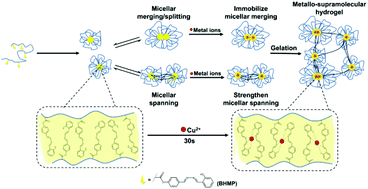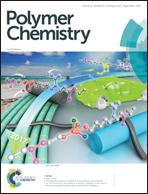Metallo-supramolecular hydrogels based on amphiphilic polymers bearing a hydrophobic Schiff base ligand with rapid self-healing and multi-stimuli responsive properties†
Abstract
Metallo-supramolecular hydrogels (MSH) with hydrophobic ligands were fabricated by a simple but versatile strategy. This strategy is expected to extend the selection of ligands in hydrogel systems and enables the forming hydrogels to have more attractive properties and applications. An amphiphilic polymer with a hydrophobic Schiff base ligand, poly(N,N-dimethylacrylamide-co-2-(benzylidene-hydrazonomethyl)-phenol) (P(DMA-co-BHMP)), was synthesized and self-assembled to micelles in aqueous solution. The addition of selected divalent metal ions (Cu2+, Co2+, Ca2+, Mn2+, Pb2+ and Fe2+) connected each micelle with metal–ligand coordination and resulted in gelation. The designed ligand with a pH sensitive Schiff base structure (BHMP) contributed to the pH-responsive properties of the prepared hydrogels. Rheological studies displayed that hydrogels crosslinked by Cu2+ (Cu-gel) were injectable and rapidly self-healing. The addition of competing ligands (EDTA and EDA) caused the degradation of Cu-gel. We also illuminated the reversible redox gel–sol transition of the hydrogel crosslinked by the resulting polymer and Fe2+ (Fe-gel). These self-healable and multi-stimuli responsive hydrogels have potential for biomedical and encapsulation–controlled release applications.



 Please wait while we load your content...
Please wait while we load your content...